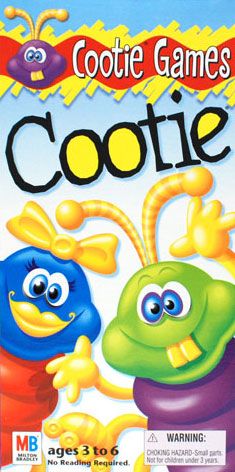Cootie (1927)
Playtime: 20
Min. Age: 3
Players: 2 - 4
Publisher: Köhler, Hasbro, Transogram, AMIGO, MB Jeux, Russimco Games, Chad Valley Co Ltd., Peter Pan Playthings, Vallbo, Zodiac Toys, MB Spiele, Toltoys, Drivabolagen AB, MB Spellen, Schaper, Brimtoy, Merit, Basic Fun, Inc., Playskool, King International, Milton Bradley, Michael Stanfield, E. S. Lowe Company Inc., House of Marbles, MB Giochi, Tyco, Universal Publications Ltd, Gibsons, Direco AB, H. P. Gibson & Sons, Gazebo Games UK Ltd., Lemeco, Pilot Plastics, Rorks, Klee, ER Juguetes
Designers: J. H. W., William Schaper
Artists: Unknown
Mechanics: Paper-and-Pencil, Dice Rolling, Set Collection
Min. Age: 3
Players: 2 - 4
Publisher: Köhler, Hasbro, Transogram, AMIGO, MB Jeux, Russimco Games, Chad Valley Co Ltd., Peter Pan Playthings, Vallbo, Zodiac Toys, MB Spiele, Toltoys, Drivabolagen AB, MB Spellen, Schaper, Brimtoy, Merit, Basic Fun, Inc., Playskool, King International, Milton Bradley, Michael Stanfield, E. S. Lowe Company Inc., House of Marbles, MB Giochi, Tyco, Universal Publications Ltd, Gibsons, Direco AB, H. P. Gibson & Sons, Gazebo Games UK Ltd., Lemeco, Pilot Plastics, Rorks, Klee, ER Juguetes
Designers: J. H. W., William Schaper
Artists: Unknown
Mechanics: Paper-and-Pencil, Dice Rolling, Set Collection
Show Description Show Comments Price Trend
Players race to construct a plastic bug, rolling a die to see which piece they get to add.
The Hennepin History Museum states that the first Cootie game was designed by William H. Schaper in 1949. However, Schaper's game was not the first based upon the insect known as the "cootie". The creature was the subject of several tabletop games, mostly pencil and paper games, in the decades of the twentieth century following World War I.
In 1927, the J. H. Warder Company of Chicago released Tu-Tee, and the Charles Bowlby Company released Cootie; though based on a "build a bug" concept similar to Schaper's, both were paper and pencil games.
Schaper's game was the first to employ a fully three dimensional, free-standing plastic cootie.
Known in Australia as Creepy Critters and in the UK as Beetle Drive.
The Hennepin History Museum states that the first Cootie game was designed by William H. Schaper in 1949. However, Schaper's game was not the first based upon the insect known as the "cootie". The creature was the subject of several tabletop games, mostly pencil and paper games, in the decades of the twentieth century following World War I.
In 1927, the J. H. Warder Company of Chicago released Tu-Tee, and the Charles Bowlby Company released Cootie; though based on a "build a bug" concept similar to Schaper's, both were paper and pencil games.
Schaper's game was the first to employ a fully three dimensional, free-standing plastic cootie.
Known in Australia as Creepy Critters and in the UK as Beetle Drive.
We currently have no price data for this game.
This game is currently not traded on the marketplace:
This game is currently not listed on the marketplace. If you want to sell yours, please add it to the marketplace.
Marketplace
The game was also published under these names:
Cootie ,
Creepy Critters ,
The Beetle Game ,
Escarabajo ,
Here is Mr. Beetle ,
Le Scarabée ,
Myrspelet ,
Rippel Tippel Käfergetrippel ,
Mein Kleiner Esel ,
The New Game of Cootie ,
Build a Beetle ,
Beetle Drive ,
Family Beetle Game ,
Deluxe Cootie ,
Lucky Ladybirds ,
Mini Cootie ,
애벌레 쿠티벅 ,
Scootie ,
Hog Wild ,
Pirate ,
Mio Piccolo Asino ,
Beetle ,
Cootie Keychain Set ,
Tu-Tee ,
Van Kop tot Staart ,
Lusen ,
The Traditional Game of Beetle ,
Forma le Formiche ,
Giant Cootie ,
Beetle Game ,
Käferspiel ,
Mon Petit Âne
Related Games
ag.gameitem.lastUpdated: 2025-06-07 13:18:39.588

















